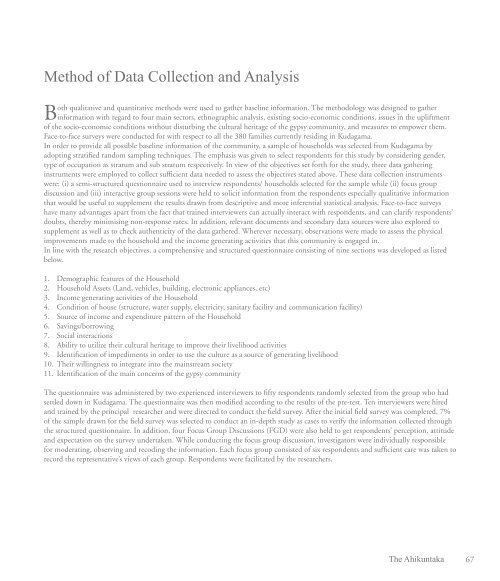The Ahikuntaka
A publication documenting the lives and livelihoods of the Ahikuntaka or gypsy community in Sri Lanka. A collection of vibrant photographs and a baseline survey on the current socio economic status of the Ahikuntaka conducted by the Colombo University complement this timely publication.
A publication documenting the lives and livelihoods of the Ahikuntaka or gypsy community in Sri Lanka. A collection of vibrant photographs and a baseline survey on the current socio economic status of the Ahikuntaka conducted by the Colombo University complement this timely publication.
You also want an ePaper? Increase the reach of your titles
YUMPU automatically turns print PDFs into web optimized ePapers that Google loves.
Method of Data Collection and Analysis<br />
Both qualitative and quantitative methods were used to gather baseline information. <strong>The</strong> methodology was designed to gather<br />
information with regard to four main sectors, ethnographic analysis, existing socio-economic conditions, issues in the upliftment<br />
of the socio-economic conditions without disturbing the cultural heritage of the gypsy community, and measures to empower them.<br />
Face-to-face surveys were conducted for with respect to all the 380 families currently residing in Kudagama.<br />
In order to provide all possible baseline information of the community, a sample of households was selected from Kudagama by<br />
adopting stratified random sampling techniques. <strong>The</strong> emphasis was given to select respondents for this study by considering gender,<br />
type of occupation as stratum and sub stratum respectively. In view of the objectives set forth for the study, three data gathering<br />
instruments were employed to collect sufficient data needed to assess the objectives stated above. <strong>The</strong>se data collection instruments<br />
were: (i) a semi-structured questionnaire used to interview respondents/ households selected for the sample while (ii) focus group<br />
discussion and (iii) interactive group sessions were held to solicit information from the respondents especially qualitative information<br />
that would be useful to supplement the results drawn from descriptive and more inferential statistical analysis. Face-to-face surveys<br />
have many advantages apart from the fact that trained interviewers can actually interact with respondents, and can clarify respondents’<br />
doubts, thereby minimising non-response rates. In addition, relevant documents and secondary data sources were also explored to<br />
supplement as well as to check authenticity of the data gathered. Wherever necessary, observations were made to assess the physical<br />
improvements made to the household and the income generating activities that this community is engaged in.<br />
In line with the research objectives, a comprehensive and structured questionnaire consisting of nine sections was developed as listed<br />
below.<br />
1. Demographic features of the Household<br />
2. Household Assets (Land, vehicles, building, electronic appliances, etc)<br />
3. Income generating activities of the Household<br />
4. Condition of house (structure, water supply, electricity, sanitary facility and communication facility)<br />
5. Source of income and expenditure pattern of the Household<br />
6. Savings/borrowing<br />
7. Social interactions<br />
8. Ability to utilize their cultural heritage to improve their livelihood activities<br />
9. Identification of impediments in order to use the culture as a source of generating livelihood<br />
10. <strong>The</strong>ir willingness to integrate into the mainstream society<br />
11. Identification of the main concerns of the gypsy community<br />
<strong>The</strong> questionnaire was administered by two experienced interviewers to fifty respondents randomly selected from the group who had<br />
settled down in Kudagama. <strong>The</strong> questionnaire was then modified according to the results of the pre-test. Ten interviewers were hired<br />
and trained by the principal researcher and were directed to conduct the field survey. After the initial field survey was completed, 7%<br />
of the sample drawn for the field survey was selected to conduct an in-depth study as cases to verify the information collected through<br />
the structured questionnaire. In addition, four Focus Group Discussions (FGD) were also held to get respondents’ perception, attitude<br />
and expectation on the survey undertaken. While conducting the focus group discussion, investigators were individually responsible<br />
for moderating, observing and recoding the information. Each focus group consisted of six respondents and sufficient care was taken to<br />
record the representative’s views of each group. Respondents were facilitated by the researchers.<br />
<strong>The</strong> <strong>Ahikuntaka</strong><br />
67















